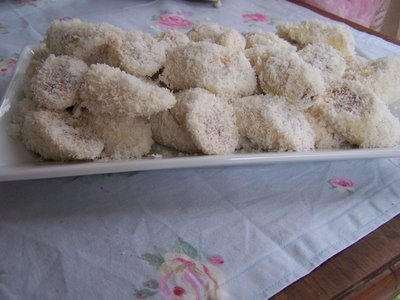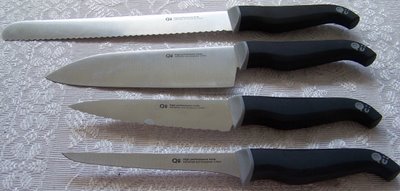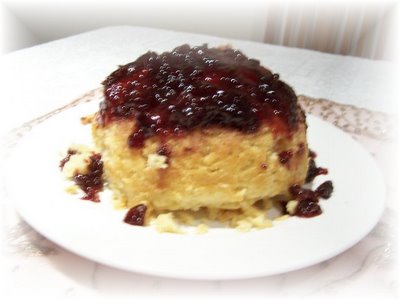
When Miss Eagle was but an eaglet and doing Domestic Science classes in Grades 7 and 8, one of the earliest items in the repertoire was Beef Olives. This was the time when the Sunday Roast and Three Veg reigned supreme. The height of culinary achievement in the Australian home at that time was the baked dinner. Now Beef Olives is a way of doing a simple baked dinner - a baked dinner on a budget, a baked dinner that did not take as long as the Sunday joint, a baked dinner simplified.
In this day and age, it is even simpler to do. The Kitchen Whizz/Food Processor takes care of the seasoning/stuffing. A convection oven - or even a microwave - can speed up the cooking time. Here is Miss Schauer's classic recipe.
BEEF, VEAL, OR MUTTON OLIVES WITH GREEN PEAS
Lay out flat 1 1/2lb of topside, badebone, or round steak, cut thin. Beat with a wet rolling pin to soften fibre. Cut steak into square pieces 4 in. x 4 in. Spread with a dessertspoon of minced bacon and shredded carrot, and dessertspoon of minced onion with a pinc of saslt and pepper. Cover smoothly with a thin layer of stuffing, made by soaking a cup of fresh breadcrumbs and a tablespoon of finely-cut parsley, seasoned with pepper and salt, mixed together with 2 tablespoons hot milk. Roll round carefully (neatly). tie in middle and ends with twine or fine string. Brown quicky in pan, in a little hot fat, all over. Place in casserole, pie-dish, or thick saucepan. Cover closely. Cook slowly about 2 hours in oven or on top of stove. Remove rolls, place on hot meat-dish. Arrange a tablespoon of hot cooked green pease between the rolls, showing on top of rolls, or a 4 in. slice of cooked carrot. Pour a teaspoon of melted margarine over vegetables. Garnish side with sliced tomato, with a touch of shredded lettuce on each and shredded lettue at end of dish.
NOTE:- The stuffing may be placed on one half of the steak, the other half folded over to form a sandwich. Prepare, cook and serve as above.
Fibre of meat may be softened by probing surface with edge of thin saucer, or end of rolling pin before stuffing and rolling.
Miss Eagle's Notes: After removing the Olives from the frying pan after browning, Miss Eagle makes a nice brown gravy (remember NO GRAVOX) using a little Parisian Essence to darken the gravy if necessary. The gravy can have additional liquid so it is rather thin. Pour the gravy over the Olives in the casserole dish and place in oven. The gravy will reduce and thicken. Keep an eye on the gravy so that it doesn't simmer away. Because of the gravy, Miss Eagle likes mashed potatoes with her Olives, along with some cauliflower and minted peas.
 A colander is an underrated implement - although, in these days of custom kitchens and up-market appliances, decorator colanders are appearing all over like this Alessi/Stark design pictured above. Colanders are often seen as only for draining things like pasta, rice, and vegetables but another use is to line one with buttered brown paper, fill with cake mixture, and use the result as a skirt for a Dolly Varden cake as my mother once did for a childhood birthday cake.
A colander is an underrated implement - although, in these days of custom kitchens and up-market appliances, decorator colanders are appearing all over like this Alessi/Stark design pictured above. Colanders are often seen as only for draining things like pasta, rice, and vegetables but another use is to line one with buttered brown paper, fill with cake mixture, and use the result as a skirt for a Dolly Varden cake as my mother once did for a childhood birthday cake.










